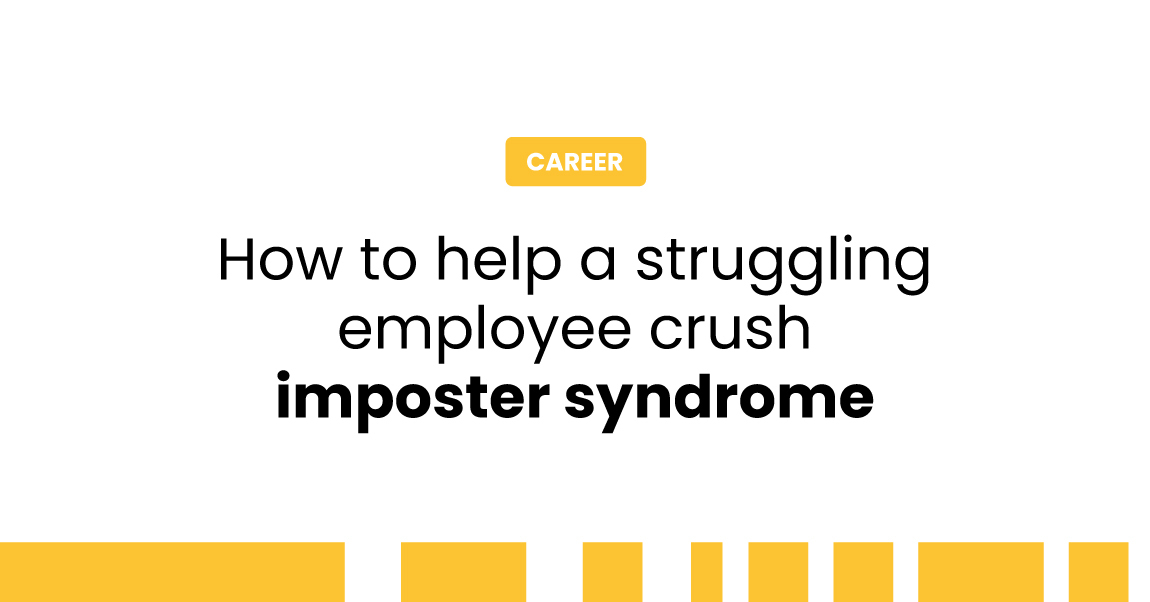Studies show that, at some point, nearly 70% of people will experience self-doubt and insecurities tied to their daily jobs. This phenomenon has a name and a definition. And it needs to be dealt with! So first, let’s define imposter syndrome in the workplace, learn what causes it, and then move on to the proven remedies that can help leaders and managers encourage their struggling employees.
A brief intro: Imposter syndrome definition
Blue Monday isn’t necessarily an 80s bop. Let’s face it – we’ve all been there at times. But some actually can’t shake the blues off and keep experiencing this overwhelming sense of failure. In other words, their good work, efforts, knowledge, and results feel like a hoax. And they can’t tell that they truly are skilled & successful. It just seems off and away. And that’s exactly what imposter syndrome feels like.
People affected by this condition tend to have a fear of being exposed as fraud. Some even attribute their past achievements to others and to external factors. So, they’re often convinced that each bullseye they’ve hit was a mere lucky break.
But here’s a key point that every good team leader and manager must live & guide by: this syndrome is very far from a realistic self-assessment. And it’s vital to understand how to deal with imposter syndrome to help out a teammate who’s being tormented by it.
What triggers imposter syndrome?
Sometimes, people start to believe that they just aren’t as skilled or smart as they’ve led others to believe. And the truth is – this misconception (and a condition) can happen to literally anyone. According to a 2020 survey, the number of workers who are currently dealing with imposter syndrome is somewhere between 10 and 82%. The figures vary depending on the respondents and the precise moment they were asked about it.
Still, certain components can spark these gloomy ideas and set off the syndrome:
- Several negative elements and outcomes in the workplace,
- The devastating aftermath of poor mental well-being,
- Personality traits such as perfectionism,
- An employee’s family and background (inclined to turn them into overachievers from a very young age),
- The sense of being different from peers (which is usually connected to race, gender, age, or other factors).
Psychologists started to describe the imposter syndrome in 1978. Since then, employees and companies worldwide have seen some substantial changes. Nowadays, with the massive wave of layoffs, recession, and numerous other global instabilities, it’s only natural that we have plenty on our plates. So, let’s pay closer attention & help each other out with anxieties and feelings of inadequacy.
5 tested tips for managing someone with imposter syndrome
Aside from granting your trusted workers a major reason for job dissatisfaction, building up a dog-eat-dog type of workplace culture will make them question their very own knowledge and worth. But aside from the ultra-competitive environments, poor communication is another answer to what causes imposter syndrome. And finally, a lack of diversity and proper mentorship will turn skillful individuals into self-doubting (and self-proclaimed) imposters. These are the key facts you absolutely need to grasp before you get ready for a rescue mission. Ensure a healthy culture that helps people grow & glow, and do your best to keep on improving the employee experience. Now, let’s start with the basic step a leader must take.
Learn to spot the warning signs
The best way to help out a teammate is by recognizing their struggles. In simple words – name it + claim it. So, a leader or manager has to be fully aware of the situation and ready to spot the warning signs fast. Then, they’ll be able to help an employee acknowledge their fears. The next step would be to identify their career goals and work out a roadmap that will lead toward them.
Now, if an employee perpetually downplays accomplishments, that should be about enough to sound the alarm. Avoiding feedback and being reluctant to ask for help are also huge red flags. And if an employee is prone to second-guessing most of their decisions, that’s also a signal that their judgment might be off. And finally, overworking and failing to finish projects are the two faces of the same coin. Both can hint that someone is dealing with imposter syndrome.
Normalize asking for help & show recognition
According to a 2014 study, impostor syndrome was the top fear of executives across the globe. In fact, 60% of them dreaded their leadership roles because of it. So, it’s obvious that this syndrome knows no hierarchy and has no boundaries. It can hit any worker out there. And that’s why it is essential to create a psychologically safe environment and encourage those who are affected to speak up and seek guidance. If you fail to recognize the importance of helping out struggling employees, you’ll just have a displeased crew that’s stuck in a dead-end loop called the comfort zone. Forever, or at least until they rage quit.
Now, we can’t just discuss imposter syndrome and reassure someone that admitting it is the healthiest option without offering something suiting. And that should be done by giving some sort of a reward, bonus, or public appraisal once the employee does their good work. Just think about the essence of human nature – and make sure to give them credit for their ideas and results.
Run strengths-based evaluations & offer specific confirmation
Duties and responsibilities sometimes make us feel cramped. Juggling multiple tasks or projects can make the imposter syndrome thrive in some cases. People lose their focus and start feeling stretched, forgetting about their actual capabilities. So, the best remedy to leverage this situation is to create a strength-based system of assessments. That way, you will make room for frequent, open dialogues with employees and help them grasp the real state of affairs. Start by clearly introducing the intent to run these evaluations. An approach like this is already widely accepted in the recruitment process, and it’s known for its objectivity and precise insights it provides.
Once the appraisal is complete, you should offer a specific review and affirmation. Half-truths and loose statements won’t get you far. So be sure to avoid generalizations at all costs when dealing with staff members (those who question their skills and outcomes in particular). Name the individual strengths they bring to the company. Show them how those exact capabilities transform the company and add to its success.
Encourage employees to make their own decisions
It’s always best to allow the employees to be decision-makers. And sometimes, you can help them understand their own potential with a gentle nudge. Let them feel trusted. After all, you’ve hired them based on their skills, knowledge, and attitude. So, you’ll gladly rely on them – make sure they know it. Now, if you ask them to draw a decision in public, you’re labeling them as a crucial figure that has the authority and necessary skillset to get the job done independently. Try it out and watch how it boosts their confidence.
Get the struggling employee a mentor
The learning curve rarely ends. For many, it’s a continued loop and a combo of various development programs. So, if you grant your employees a mentor, they’ll embrace the chance to amplify their expertise (and get rid of the negative thoughts and doubts).
💡 Here’s a pro tip: Get them a mentor who comes from a familiar place. Similar demographics, for instance, can be incredibly helpful.
Every now and then, people get trapped by imposter syndrome when they feel like they don’t deserve to be in their role. And there’s usually an unrelated trait or characteristic stopping them from succeeding. A mentor with a matching background will build up the employee’s confidence, so they no longer feel like a fraud.
Help your employees learn how to overcome imposter syndrome at work
So, how do you address imposter syndrome in the workplace? Get started with the basics. Learn more about it and stay alert for the warning signs. Then, make sure to follow the steps we’ve described. Be accessible, acknowledge their fears and issues, and work together on solving them. Focus on the strengths and be very clear about the expectations and results. Make your feedback detailed and on-target. Finally, be open to providing a mentorship opportunity to those who feel like their knowledge (and position) is a hoax.
Hire the right people & keep making sure that they’re crashing it! Mind their well-being and boost their morale.




